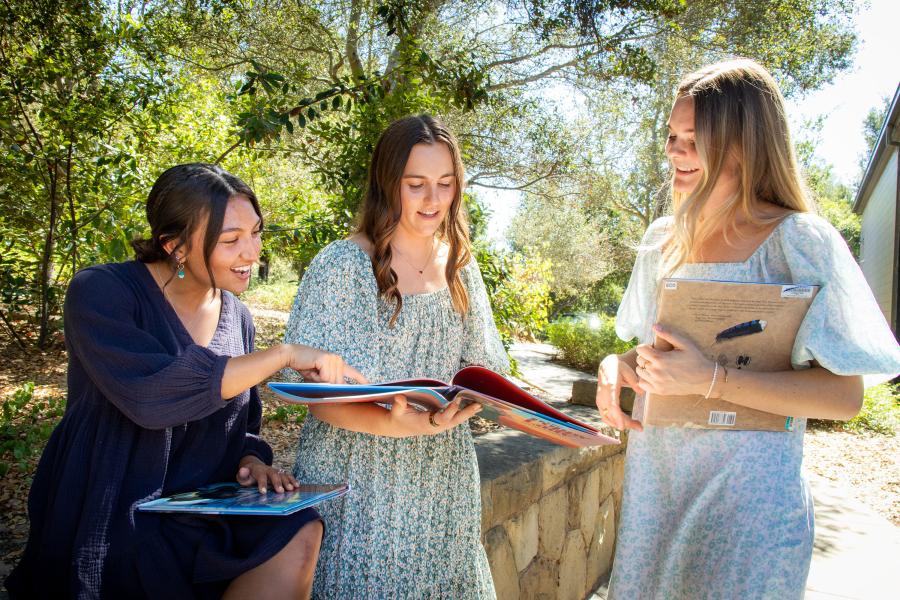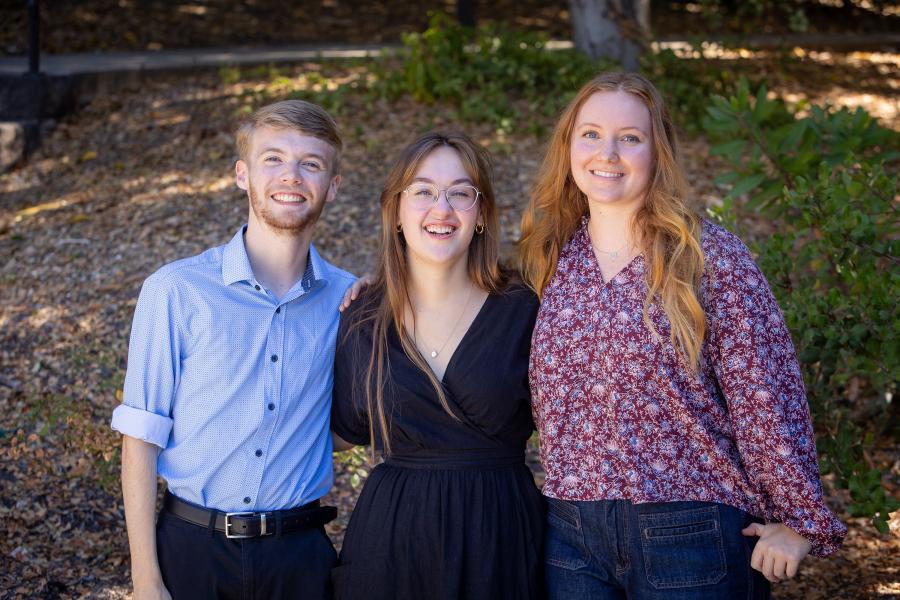Westmont News
Westmont's 21st annual Celebration of Teaching Celebrating New Teachers

By
Scott Craig
A standing-room only crowd attended the Westmont Department of Education’s 21st annual Celebration of Teaching to honor the 13 graduates and their cooperating teachers April 25 in Westmont’s Founders Room. The student teacher presentations were interspersed with heartwarming slideshows, videos and talks by professors Andrew Mullen and Carolyn Mitten.

The student teachers included Hannah Hutton, Christine Venzor, Ashley Kytlica, Chloe Harber, Claudia Canizares Guerra, Kiersten Patzia, Brenna Tang, Mikaela Vander Molen, Kira Mark, Macey Preciado, Faith Tonelli, Matthew Wiese and Julia White. They were placed at Canalino, Cleveland, Monte Vista and Vieja Valley Schools as well as San Marcos and Dos Pueblos High Schools.
Hutton, who spoke about “Tailor Made,” said any any teacher can pick up a lesson plan, but real teaching, transformative teaching, comes from relationship. “My strategies will change with every class I teach. But the heart of it? That won’t change,” she says. “Every student is tailor made. And I want my teaching to be tailor made too.”
Venzor spoke about “The First Sprouts,” reflecting on the process of teaching and comparing it to growing brassica flowers, which require patience and care. “The growth will come, not always in the way I expect it and not always with my timing, but one day, probably when I least expect it, I will see a tiny sprout and remember why the waiting was worth it, because it is always worth it.
Kytlica explored “The Pieces of the Puzzle,” drawing a parallel between teaching and assembling a puzzle, where each student is a piece that contributes to the overall classroom community. “It has to be built on love — to love your students well as a teacher,” she said. “It takes time and it can be tough, but I want my students to walk away every day, knowing I love and care for them.”
Harber drew parallels to Jesus’ life in “The Gospel in the Classroom,” discussing the challenges of humility and the importance of justice and fairness in teaching. “They challenged me to make sure I was giving attention to all of my students, even when that meant sitting with the ones, who had to be reminded to pay attention every three seconds, and not giving up just because they seemed like a lost cause,” she said.

Guerra highlighted the importance of joy, connection, and presence over perfection in her talk, “A Little Joy,” sharing anecdotes about students' spontaneous moments of learning and affection. “Teaching is more than a profession,” she said. “It's a calling. It's a sacred invitation to be a part of someone's growing up story, to laugh, to cry, to learn and to grow.”
Reflecting on her experience as a student teacher, Patzia examined “The Art of Listening: A Teacher’s Perspective.” She said students often share personal stories and emphasized listening to help them feel seen and cared for, which can also enhance learning. “Many students have difficult home lives, and as teachers, we might be the only adult that truly listens to them and values what they have to say,” she said. “While it's important to get through the lesson, it’s also important to slow down and allow students to share their thoughts, feelings and struggles.”
Tang emphasize the importance of personalized attention and small gestures, such as giving students birthday pencils in her talk, “To Be Seen.” “There is no way we can understand the impact of a small loving gesture on a student who needs that in that moment,” she said. “The disposition shift in every student when they realize they are loved is undeniable.”
Vander Molen offered “Three Lessons” she’s learned from her students: discovering peace in imperfection; cherishing the good moments; and trusting in a providential God. “The most effective teachers are not those who spend all their time mastering their skills in teaching, rather those who have mastered being a student,” she said.
Mark, who’s talk “Roses and Thorns” told the story of a lesson gone awry, learned to focus on positive moments of teaching that helped her regain confidence. “My responsibility is to water the seeds of friendship, community and enjoyment of learning that God has planted,” she said, “but ultimately, I must surrender that transformation to God and marvel at how a beautifully made flower can emerge from a bundle of thorns.”
Preciado discussed the concept of joy in her talk, “Pockets of Joy,” which is often seen as fleeting and dependent on circumstances rather than rooted in Jesus. “Joy persists in spite of failure, hardship and trials,” she said. When a lesson that I thought would really hit turns out to be a disaster, joy views my mistakes as teachable moments.”
Tonelli shared “A Kid, a Tree and the Lessons They Taught Me,” which explored a lesson she learned about failure, following a project that went awry and led to a transformative moment. “The project itself had fallen apart, but the real lesson, the one I hoped to teach, had emerged in a way I never could have anticipated,” she said. “It wasn't really about the project at all, it was about kindness and putting it into action.”
Wiese highlighted the challenges high school students face, such as anxiety, depression and societal issues in his talk, “Our Learning is Bound up Together.” “History is so amazing because it is a case study of humanity,” he said. “It’s a way of better understanding humanity. And when we begin to better understand humanity. You begin to see our reliance upon each other. You begin to understand how our lives are bound together.”
White shared a poetic reflection on teaching, likening it to a culinary process that blends various ingredients in “The Table of Learning: A Teacher’s Recipe for Fat Souls.” We are not just brains on sticks,” she said. “We are embodied individuals who need nourishment, and this has become a foundational concept to my understanding of what it means to be a good teacher.”